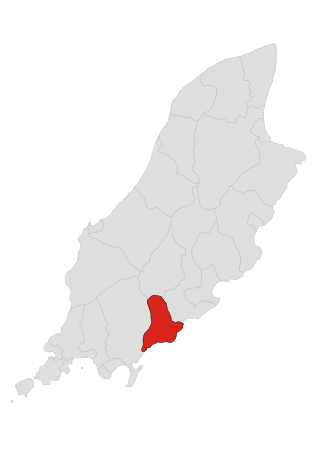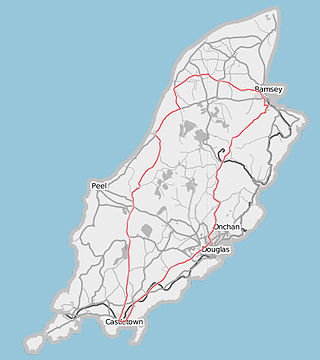
The Isle of Man is an island in the Irish Sea, between Great Britain and Ireland in Northern Europe, with a population of almost 85,000. It is a British Crown dependency. It has a small islet, the Calf of Man, to its south. It is located at 54°15′N4°30′W.

A promontory fort is a defensive structure located above a steep cliff, often only connected to the mainland by a small neck of land, thus using the topography to reduce the ramparts needed.

Snaefell – is the highest mountain and the only summit above 2,000 feet (610 m) on the Isle of Man, at 2,037 feet (620.9 m) above sea level. The summit is crowned by a railway station, cafe and several communications masts.

Bradda Hill is a headland some 2 kilometres (1.2 mi) north of the village of Port Erin on the Isle of Man. It is not to be confused with Bradda Head which is about 2 kilometres (1.2 mi) to the SW.

Manx English, or Anglo-Manx, is the historic dialect of English spoken on the Isle of Man, though today in decline. It has many borrowings from Manx, a Goidelic language, and it differs widely from any other variety of English, including dialects from other areas in which Celtic languages are or were spoken, such as Welsh English and Hiberno-English.

Michael is one of the six sheadings of the Isle of Man. It is located on the west of the island and consists of the three historic parishes of Ballaugh, Jurby and Michael.

Rushen, formally Kirk Christ Rushen, is one of the seventeen historic parishes of the Isle of Man.

Santon, historically Santan, is one of the seventeen historic parishes of the Isle of Man.

Highroads Course was a road-racing circuit used for the Gordon Bennett British Eliminating Trial held in the Isle of Man for the 1904 and 1905 Tourist Trophy Race involving touring automobiles and cars. The events were held on public roads closed for racing by an Act of Tynwald.

Bradda Head is a rugged headland overlooking Port Erin, a popular seaside village in the south-west of the Isle of Man, in the British Isles. Rising to a height of 382 feet (116 m) above sea level.
Laurel Bank is situated between the 10th Milestone and 11th Milestone road-side markers on the primary A3 Castletown to Ramsey Road between Ballacraine and Glen Helen in the parish of Kirk German in the Isle of Man.

Raad ny Foillan is a coastal long-distance footpath in the Isle of Man. Because it is a closed loop around the coast, it can be walked in either a clockwise or an anti-clockwise direction.

Cronk-ny-Mona is situated between the 36 and 37 mile markers used for the Snaefell Mountain Course, being on the primary A18 Mountain Road at the road junction with the A21 Johnny Watterson('s) Lane and the tertiary C10 Scholag Road in the Isle of Man parish of Onchan.
Cronk Urleigh is a stretch of road situated at the 15th Milestone on the primary A3 Castletown to Ramsey in the parish of Kirk Michael in the Isle of Man.

North Barrule is the second highest peak in the Isle of Man at 565 metres (1,854 ft). From the summit the northern plain of the Isle of Man can be viewed along with the coastlines of Ireland, Cumbria, Wales and Scotland.

The Isle of Man is mostly hilly, but has only one summit, Snaefell, classified as a mountain.

John Moore Jeffcott QC was a Manx advocate who became High Bailiff of Castletown and a Member of the House of Keys for the constituency of Castletown.
The geology of the Isle of Man consists primarily of a thick pile of sedimentary rocks dating from the Ordovician period, together with smaller areas of later sedimentary and extrusive igneous strata. The older strata was folded and faulted during the Caledonian and Acadian orogenies The bedrock is overlain by a range of glacial and post-glacial deposits. Igneous intrusions in the form of dykes and plutons are common, some associated with mineralisation which spawned a minor metal mining industry.
















